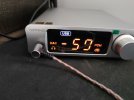Interesting and good to know this from people like yourself

General consumers without the necessary electrical knowledge like me will probably use and review the product as is. Are there any risks of shorting/unhealthy voltage/current levels by doing so, however?
if you choose method 2) it's extremely safe and there will be no disadvantage. it's called "impedance balanced" and many professional audio equipments are wired this way. it has all the nice properties balanced output has, such as common mode noise rejection, ground loop elimination, etc.
See the table in
http://www.paformusic.org.uk/gl_b.htm#Balanced
The maximum output is 2V instead of 4V. if you don't listen at that high volume a lower voltage is even better.
This means even DX5 has 6 db higher dynamic range, because 4V is 6db hotter than 2V, DX3Pro+ has the same low absolute noise level as DX5.
The RCA to XLR connector is easy to do: connect RCA+ to XLR Pin 2, RCA ground to XLR Pin 1, and a 20Ohm resistor between XLR pin 1 and 3. Then you're all set.
The method works because the 20Ohm resistor is exactly what DX3 Pro+ has in its final output circuit.
Here's the wiring from google image search:
(please replace the 100 Ohm to 20Ohm)
See it in action:
If you want to apply this solution to another unbalanced product, you have to change the resistor value.
In some rare cases, you need to get the DAC output circuit and copy more passive components to Pin3 as well.
Fortunately for DX3Pro+ only a 20Ohm resistor is needed.
Conclusion: If you don't need full 4V output, just stay with your DX3 Pro+. It's trivial to make it balanced.
Don't purchase DX5 for its balanced output.

